
The Beauty of Dianthus Flowers
Published: 07/05/2024 | Updated: 28/05/2024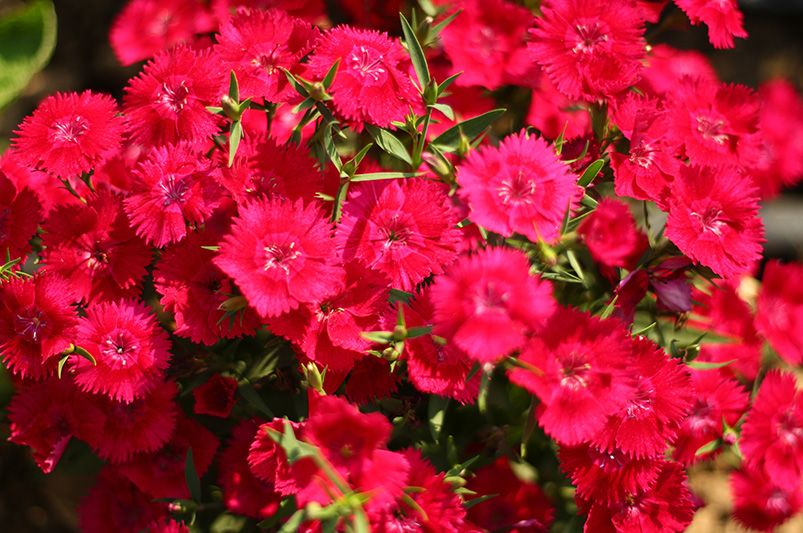
Elevate your landscape and cultivate a flourishing outdoor oasis with the captivating beauty of dianthus flowers. This guide explores the versatility and allure of dianthus while offering expert advice to cultivate them successfully.


For comprehensive landscaping and gardening solutions, visit Shrubhub blog. Our team of design professionals curates a blog featuring insightful articles, practical recommendations, and inspiring ideas for garden design and maintenance. Whether you’re a seasoned gardener or an enthusiastic beginner, ShrubHub equips you with the knowledge to cultivate your dream garden.
This guide delves into the captivating realm of dianthus flowers. We’ll explore their diverse range of colors, forms, and applications within your garden design. From planting fundamentals to proper pruning techniques, this guide offers expert-backed information to ensure your dianthus thrives.
Join us on this botanical adventure as we unveil the vibrant world of dianthus flowers. Let’s create a garden that awakens your senses and fosters a sense of tranquility.
Exploring Dianthus Varieties:
Dianthus flowers come in a stunning array of varieties, each offering its unique charm and allure. Let's take a closer look at some common dianthus species:

1. Dianthus Eastern Star:
"Dianthus Eastern Star" is a specific cultivar of dianthus, a flowering plant in the Caryophyllaceae family. This particular cultivar is known for its striking appearance and is popular among gardeners for its vibrant flowers and compact growth habit.
The "Eastern Star" variety of dianthus typically features bright pink to magenta flowers with a distinctive fringed or serrated edge on the petals. The flowers often have a spicy, clove-like fragrance, which is a characteristic trait of many dianthus varieties.

2. Dianthus Paint The Town Red:
"Dianthus Paint The Town Red" is another cultivar of dianthus, known for its vibrant red flowers. Like other dianthus varieties, "Paint The Town Red" is prized for its attractive blooms, compact growth habit, and often spicy fragrance. With vibrant red flowers and a compact growth habit, this dianthus variety adds a bold splash of color to any landscape.
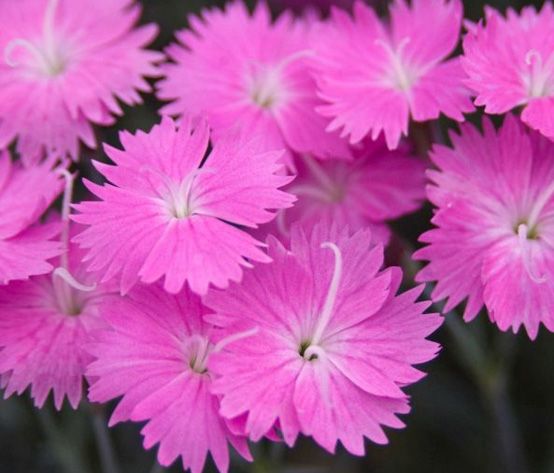
3. Firewitch Dianthus:
Known for its brilliant magenta blooms and evergreen foliage, Firewitch dianthus is a standout choice for rock gardens and borders. This variety is exceptionally hardy and tolerates a wide range of soil conditions, from sandy to clay. Firewitch dianthus blooms profusely in early summer and emits a delightfully spicy fragrance, making it a favorite for gardeners looking to add color and fragrance to their outdoor spaces.
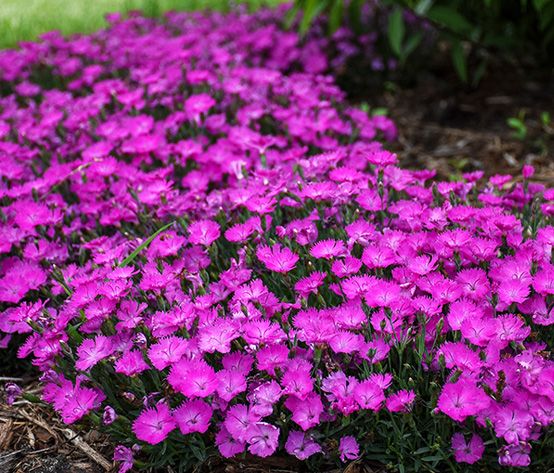
4. Paint The Town Fuchsia Dianthus:
A showstopper in the garden, this dianthus variety boasts large, fuchsia-colored flowers that command attention. Paint The Town Fuchsia dianthus is a versatile plant that thrives in both containers and garden beds. Its compact growth habit and long blooming period make it an excellent choice for adding color to patio containers or mixed borders, while its double flowers add extra texture and visual appeal to rock gardens.
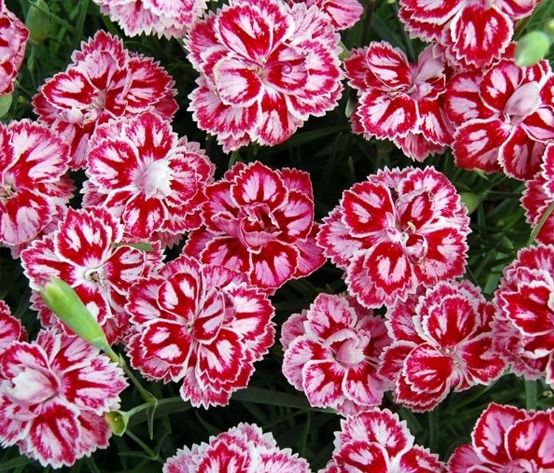
5. Star Starburst Dianthus:
With its unique starburst pattern and vibrant hues, this dianthus variety adds a touch of whimsy to garden beds and containers. Star Starburst dianthus features double blooms with fringed edges, creating a striking display in the garden. Plant it in well-drained soil and full sun to encourage abundant flowering throughout the season, and use it to add color and texture to rock gardens and mixed flower beds.
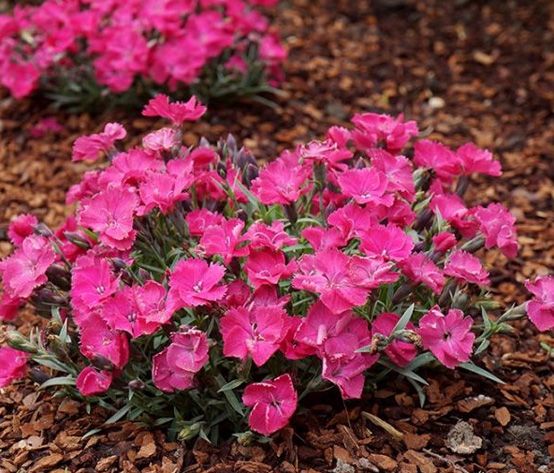
6. Vivid Bright Light Dianthus:
True to its name, this dianthus variety dazzles with its vivid, bright blooms, creating a cheerful atmosphere wherever it's planted. Vivid Bright Light dianthus is a prolific bloomer, producing an abundance of flowers from spring to fall. It thrives in sunny locations and is drought-tolerant once established, making it an ideal choice for low-maintenance landscapes. Use it to add pops of color to rock gardens, border plantings, and container gardens.

7. Red Fire Dianthus:
"Red Fire" Dianthus is a specific cultivar of dianthus, known botanically as Dianthus deltoides 'Red Fire'. It is named for its fiery red flowers and is valued for its attractive blooms and compact growth habit. Red Fire Dianthus produces vibrant red flowers with a classic dianthus fringed or serrated edge on the petals. The flowers are typically small but plentiful, creating a striking display when in bloom. This cultivar forms low mounds of evergreen foliage, typically reaching around 6 to 8 inches (15 to 20 centimeters) in height and spreading about 12 to 18 inches (30 to 45 centimeters) wide. Its compact, spreading habit makes it suitable for use as ground cover or for edging garden beds and pathways.
Each of these dianthus varieties offers something special, from eye-catching colors to exquisite patterns. Whether you're a seasoned gardener or just starting, there's a Dianthus variety to suit every taste and style. Ready to add some dianthus dazzle to your garden? Explore our wide selection of premium dianthus varieties at ShrubHub and bring a burst of color and beauty to your outdoor space. Visit our store to shop now!
Growing Dianthus Plants
Dianthus plants, also known as carnations or pinks, are beautiful flowering plants that can thrive with proper care. Here are some tips to ensure healthy growth and establishment for your dianthus plants:
-
Choose the Right Location: Dianthus plants prefer full sun to partial shade. Select a location in your garden that receives at least 6 hours of sunlight per day.
-
Well-Drained Soil: Ensure the soil is well-drained and slightly alkaline with a pH between 6.0 and 7.5. Sandy or loamy soil works well for dianthus plants.
-
Ample Air Circulation: Plant dianthus in an area with good air circulation to prevent fungal diseases. Avoid overcrowding them with other plants.
-
Watering: Water dianthus plants regularly, keeping the soil consistently moist but not waterlogged. Avoid overhead watering to prevent foliage diseases.
-
Mulching: Apply a layer of mulch around the base of the plants to help retain moisture, regulate soil temperature, and suppress weed growth.
-
Fertilization: Fertilize dianthus plants with a balanced, slow-release fertilizer in the spring when new growth appears. Follow the manufacturer's instructions for application rates.
-
Deadheading: Remove spent flowers regularly to encourage continuous blooming throughout the growing season and prevent the plant from expending energy on seed production.
-
Pruning: Trim back leggy or spent stems to promote bushy growth and maintain a tidy appearance. Cut back the entire plant by about one-third after the first flush of flowers to encourage a second bloom.
-
Pest and Disease Control: Keep an eye out for pests like aphids, thrips, and spider mites, as well as diseases like powdery mildew and root rot. Treat any infestations or infections promptly with appropriate methods, such as insecticidal soap or fungicides.
-
Winter Protection: In colder climates, provide winter protection by applying a layer of mulch around the base of the plants and covering them with a layer of straw or evergreen boughs to insulate them from freezing temperatures.
Propagating Dianthus:
Dianthus, a diverse genus of flowering plants, offers gardeners a wealth of beauty and charm. To expand your dianthus collection and enhance your garden’s allure, propagation is key. Let’s delve into the art of propagating dianthus plants:
-
Cuttings: Propagating dianthus from cuttings is a popular method because it produces clones of the parent plant. Take cuttings from healthy, non-flowering stems in spring or early summer. Cut a 3-4 inch (7.5-10 cm) section of stem just below a leaf node. Remove the lower leaves, dip the cut end in rooting hormone, and plant the cutting in a pot filled with moistened potting mix. Keep the soil consistently moist and place the pot in a warm, bright location. Roots should develop in 3-4 weeks.
-
Division: Dianthus plants can be divided to create new plants. This is typically done in early spring or early fall when the plant is not actively flowering. Dig up the entire plant and gently separate the clumps into smaller sections, ensuring each section has roots attached. Replant the divisions in well-prepared soil, water thoroughly, and keep them well-watered until established.
-
Layering: Layering is another propagation method for dianthus. Select a healthy, flexible stem and gently bend it down to the ground. Make a small incision on the underside of the stem where it touches the soil, then cover the incision with soil and secure it in place with a small stone or piece of wire. Keep the soil consistently moist, and roots should develop at the point of contact within a few weeks. Once roots have formed, you can sever the stem from the parent plant and transplant the new plant.
Conclusion:
In conclusion, dianthus plants stand as a testament to nature’s beauty and resilience, offering gardeners diverse colors, textures, and fragrances to enhance their outdoor spaces. From their charming blooms to their easy propagation, dianthus plants continue to captivate and inspire gardeners of all levels.
Ready to transform your garden with the enchanting beauty of dianthus plants? Explore our wide variety of high-quality trees, shrubs, and ground covers at ShrubHub. With our comprehensive shopping list featuring all the elements and decor used, you can create the garden of your dreams. Visit ShrubHub today and let your gardening journey begin!


